| Weight | 1 lbs |
|---|---|
| Dimensions | 9 × 5 × 2 in |
| host | mouse |
| isotype | IgG |
| clonality | monoclonal |
| concentration | concentrate, predilute |
| applications | IHC |
| reactivity | human |
| available size | 0.1 mL, 0.5 mL, 1 mL concentrated, 7 mL prediluted |
rabbit anti-PSAP monoclonal antibody (ZR443) 6350
Price range: $160.00 through $528.00
Antibody summary
- Rabbit monoclonal to PSAP
- Suitable for: Immunohistochemistry (formalin-fixed, paraffin-embedded tissues)
- Reacts with: Human
- Isotype:IgG
- Control: Human prostate
- Visualization: Cytoplasmic
- 0.1, 0.5, 1.0 mL concentrated, 7 mL prediluted
rabbit anti-PSAP monoclonal antibody ZR443 6350
| target relevance |
|---|
| Protein names Prostatic acid phosphatase (PAP) (EC 3.1.3.2) (5'-nucleotidase) (5'-NT) (EC 3.1.3.5) (Acid phosphatase 3) (Ecto-5'-nucleotidase) (Protein tyrosine phosphatase ACP3) (EC 3.1.3.48) (Thiamine monophosphatase) (TMPase) [Cleaved into: PAPf39] |
| Gene names ACP3,ACP3 ACPP |
| Protein family Histidine acid phosphatase family |
| Mass 44566Da |
| Function FUNCTION: A non-specific tyrosine phosphatase that dephosphorylates a diverse number of substrates under acidic conditions (pH 4-6) including alkyl, aryl, and acyl orthophosphate monoesters and phosphorylated proteins (PubMed:10506173, PubMed:15280042, PubMed:20498373, PubMed:9584846). Has lipid phosphatase activity and inactivates lysophosphatidic acid in seminal plasma (PubMed:10506173, PubMed:15280042). {ECO:0000269|PubMed:10506173, ECO:0000269|PubMed:15280042, ECO:0000269|PubMed:20498373, ECO:0000269|PubMed:9584846}.; FUNCTION: [Isoform 2]: Tyrosine phosphatase that acts as a tumor suppressor of prostate cancer through dephosphorylation of ERBB2 and deactivation of MAPK-mediated signaling (PubMed:20498373). In addition to its tyrosine phosphatase activity has ecto-5'-nucleotidase activity in dorsal root ganglion (DRG) neurons. Generates adenosine from AMP which acts as a pain suppressor (By similarity). {ECO:0000250|UniProtKB:Q8CE08, ECO:0000269|PubMed:20498373}.; FUNCTION: [PAPf39]: (Microbial infection) Forms amyloid beta-sheet fibrils in semen. These fibrils, termed SEVI (semen-derived enhancer of viral infection) capture HIV virions, attach them to target cells and enhance infection (PubMed:18083097, PubMed:19451623, PubMed:19897482). SEVI amyloid fibrils are degraded by polyphenol epigallocatechin-3-gallate (EGCG), a constituent of green tea (PubMed:19451623). Target cell attachment and enhancement of HIV infection is inhibited by surfen (PubMed:19897482). Also similarly boosts XMRV (xenotropic murine leukemia virus-related virus) infection (PubMed:19403677). {ECO:0000269|PubMed:18083097, ECO:0000269|PubMed:19403677, ECO:0000269|PubMed:19451623, ECO:0000269|PubMed:19897482}. |
| Catalytic activity CATALYTIC ACTIVITY: Reaction=a phosphate monoester + H2O = an alcohol + phosphate; Xref=Rhea:RHEA:15017, ChEBI:CHEBI:15377, ChEBI:CHEBI:30879, ChEBI:CHEBI:43474, ChEBI:CHEBI:67140; EC=3.1.3.2; Evidence={ECO:0000269|PubMed:10506173, ECO:0000269|PubMed:15280042, ECO:0000269|PubMed:9584846}; CATALYTIC ACTIVITY: Reaction=1-(9Z-octadecenoyl)-sn-glycero-3-phosphate + H2O = 1-(9Z-octadecenoyl)-sn-glycerol + phosphate; Xref=Rhea:RHEA:39835, ChEBI:CHEBI:15377, ChEBI:CHEBI:43474, ChEBI:CHEBI:74544, ChEBI:CHEBI:75757; Evidence={ECO:0000269|PubMed:10506173}; PhysiologicalDirection=left-to-right; Xref=Rhea:RHEA:39836; Evidence={ECO:0000305|PubMed:10506173}; CATALYTIC ACTIVITY: Reaction=a ribonucleoside 5'-phosphate + H2O = a ribonucleoside + phosphate; Xref=Rhea:RHEA:12484, ChEBI:CHEBI:15377, ChEBI:CHEBI:18254, ChEBI:CHEBI:43474, ChEBI:CHEBI:58043; EC=3.1.3.5; Evidence={ECO:0000250|UniProtKB:Q8CE08}; CATALYTIC ACTIVITY: Reaction=O-phospho-L-tyrosyl-[protein] + H2O = L-tyrosyl-[protein] + phosphate; Xref=Rhea:RHEA:10684, Rhea:RHEA-COMP:10136, Rhea:RHEA-COMP:20101, ChEBI:CHEBI:15377, ChEBI:CHEBI:43474, ChEBI:CHEBI:46858, ChEBI:CHEBI:61978; EC=3.1.3.48; Evidence={ECO:0000269|PubMed:20498373}; |
| Subellular location SUBCELLULAR LOCATION: [Isoform 1]: Secreted {ECO:0000305|PubMed:17638863}.; SUBCELLULAR LOCATION: [Isoform 2]: Cell membrane {ECO:0000269|PubMed:17638863, ECO:0000269|PubMed:17897319, ECO:0000269|PubMed:20498373}; Single-pass type I membrane protein {ECO:0000255}. Lysosome membrane {ECO:0000269|PubMed:17638863, ECO:0000269|PubMed:17897319}; Single-pass type I membrane protein {ECO:0000255}. Nucleus {ECO:0000269|PubMed:20498373}. Cytoplasm, cytosol {ECO:0000269|PubMed:20498373}. Note=Appears to shuttle between the cell membrane and intracellular vesicles. Colocalizes with FLOT1 at cell membrane and in intracellular vesicles (PubMed:17638863). Colocalizes with LAMP2 on the lysosome membrane (PubMed:17897319). {ECO:0000269|PubMed:17638863, ECO:0000269|PubMed:17897319}. |
| Tissues TISSUE SPECIFICITY: Highly expressed in the prostate, restricted to glandular and ductal epithelial cells. Also expressed in bladder, kidney, pancreas, lung, cervix, testis and ovary. Weak expression in a subset of pancreatic islet cells, squamous epithelia, the pilosebaceous unit, colonic neuroendocrine cells and skin adnexal structures. Low expression in prostate carcinoma cells and tissues. {ECO:0000269|PubMed:17638863, ECO:0000269|PubMed:21487525}.; TISSUE SPECIFICITY: [Isoform 2]: Widely expressed. Expressed in the sarcolemma of skeletal muscle. {ECO:0000269|PubMed:17638863}. |
| Structure SUBUNIT: Homodimer; dimer formation is required for phosphatase activity. {ECO:0000250|UniProtKB:P20646}. |
| Post-translational modification PTM: N-glycosylated. High mannose content, partially sialylated and fucosylated biantennary complex. Also fucosylated with partially sialylated triantennary complex oligosaccharides. {ECO:0000269|PubMed:10639192, ECO:0000269|PubMed:12525165}.; PTM: Proteolytically cleaved in seminal fluid to produce several peptides. Peptide PAPf39, the most prominent, forms amyloid beta-sheet fibrils, SEVI (semen-derived enhancer of viral infection). {ECO:0000269|PubMed:18083097}. |
| Target Relevance information above includes information from UniProt accession: P15309 |
| The UniProt Consortium |
Data
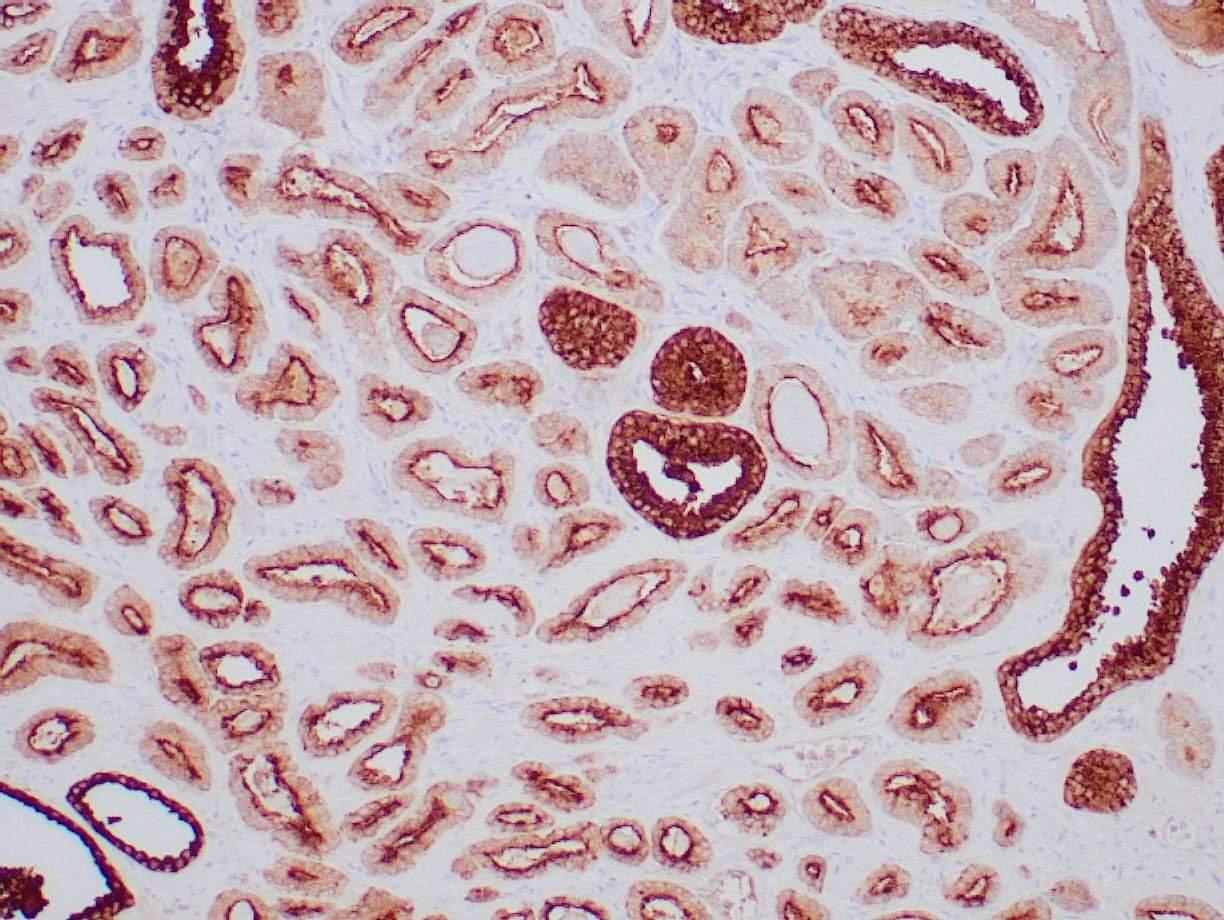 |
| Human prostate stained with anti-PSAP antibody using peroxidase-conjugate and DAB chromogen. Note the cytoplasmic staining of benign prostate glands. |
Publications
| pmid | title | authors | citation |
|---|---|---|---|
| We haven't added any publications to our database yet. | |||
Protocols
| relevant to this product |
|---|
| IHC |
Documents
| # | SDS | Certificate | |
|---|---|---|---|
| Please enter your product and batch number here to retrieve product datasheet, SDS, and QC information. | |||
Only logged in customers who have purchased this product may leave a review.
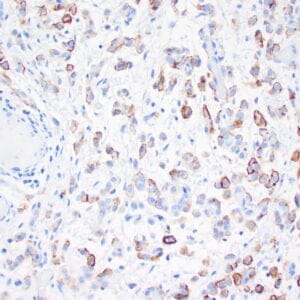
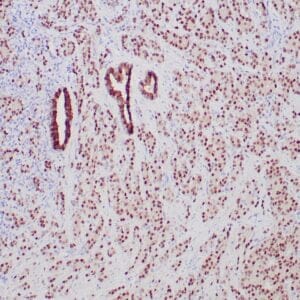
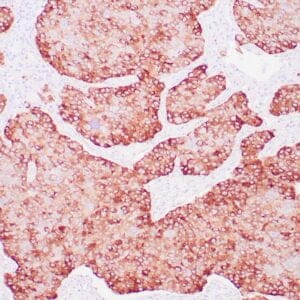


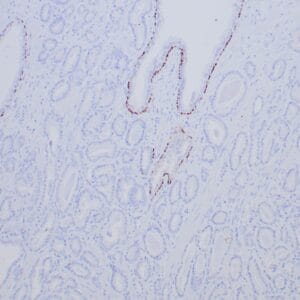

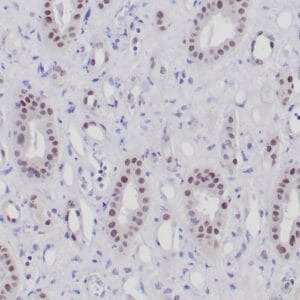
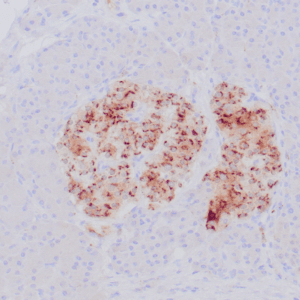
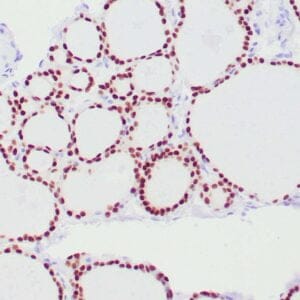
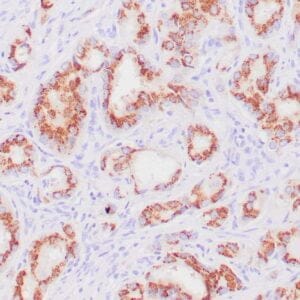
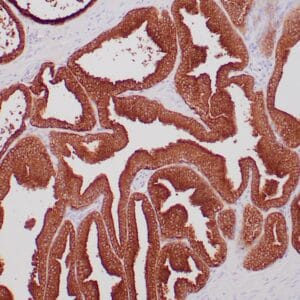
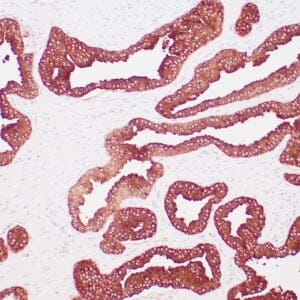
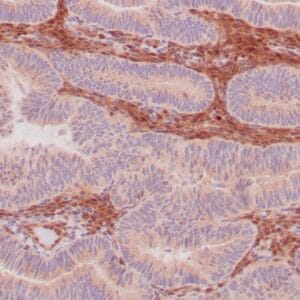
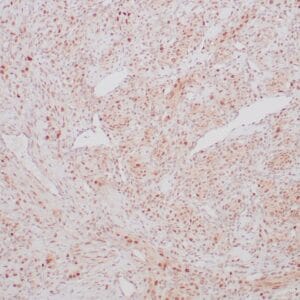
Reviews
There are no reviews yet.